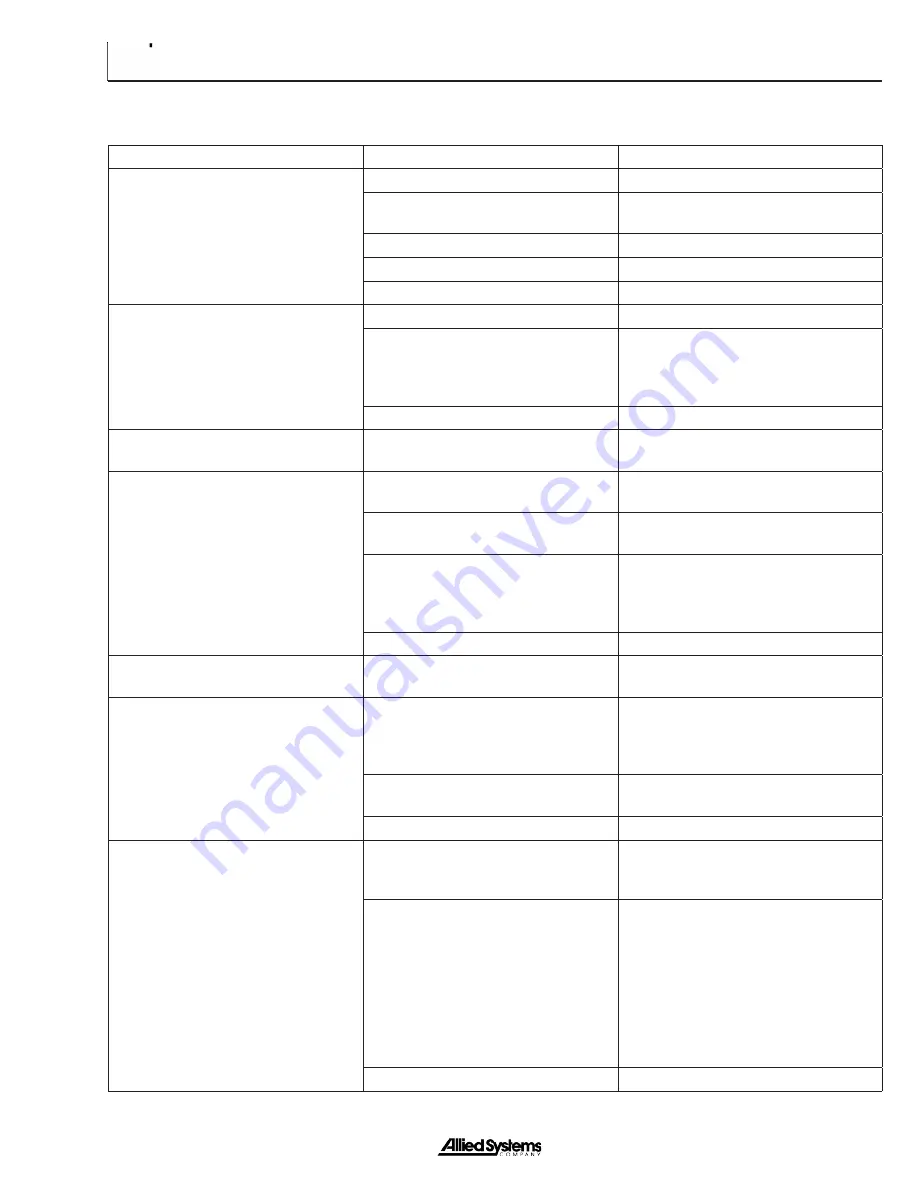
Section 2
2 - 3
Figure 2-1 Troubleshooting Analysis Check Chart -1
PROBLEM
POSSIBLE CAUSE
CORRECTION
Winch gets very hot
Low oil level.
Add oil; refer to tractor oil specifications.
Improper oil viscosity.
Use correct oil grade; refer to tractor oil
specifications.
Winch coated with dirt.
Clean winch.
Clogged filter or strainer.
Replace tractor filter.
Clogged cooler.
Clean cooler.
Operation is rough
Low oil level.
Add oil; refer to tractor oil specifications.
Low pilot pressure.
Normal pressure is above 500 psi. Look
for leaks in hydraulic system. If none
are found, see Pilot Supply Reducing
Valve Adjustment.
Wire rope jumps layers on drum.
Spool cable more evenly.
Winch chatters in
LINE-OUT
operation
(lightly loaded or no load)
Incorrect accumulator charge.
Check charge pressure.
Operation is noisy
Incorrect oil used.
Drain reservoir and re-fill with correct
oil; refer to tractor oil specifications.
Air in the hydraulic oil (indicated by
foaming or milky-colored oil).
Replace oil and inspect for leaks and
other sources of air induction.
Motor damaged.
Some noise is normal. However,
excessive clattering could indicate
damage. Inspect pump and motor
thoroughly.
Gear or bearing damage.
Visually inspect & repair as needed.
Winch chatters in
LINE-OUT
operation
(lightly loaded or no load)
Incorrect accumulator charge.
Check charge pressure.
Drum continues to rotate after lever is
returned to
BRAKE-ON
Direction spool not shifting to centered
position.
Direction spool sticking. Clean or
replace.
Control lever valve plunger sticking.
Repair.
Brake not engaged or worn.
Brake release pressure is not venting.
Check for trapped pressure.
Counterbalance valve stuck open.
Repair or replace valve.
Winch will not generate sufficient line
pull or does not line in or line out
(Continued on next page)
Worn or damaged components in the
gear train.
Visually Inspect to identify damaged
components. Repair and replace as
necessary.
Brake not releasing due to insufficient
brake release pressure or leak in
brake.
Check that brake release pilot pressure
is more than 300 psi in
LINE-IN
and
LINE-OUT
functions. If pilot pressure
is too low, check for leaks, faulty
control lever, or insufficient pilot supply
pressure. See Step By Step Pump and
Controller Troubleshooting section in
this chapter. If brake is leaking, repair
as needed.
Brake shuttle valve stuck.
Clean or replace as necessary.
Troubleshooting Analysis Check Chart
Summary of Contents for H6H
Page 3: ......
Page 9: ...vi Notes...
Page 49: ...General 1 40 Notes...
Page 65: ...General 1 56 Notes Notes...
Page 71: ...Troubleshooting 2 6 Notes...
Page 78: ...Section 3 3 7 Notes...
Page 79: ...Service 3 8 Notes...
Page 84: ...Section 4 4 5 Intentionally Blank...
Page 92: ...Section 4 4 13 7 Remove the counterbalance relief manifold...
Page 96: ...Section 4 4 17 Intentionally Blank...
Page 98: ...Section 4 4 19 7 Separate the clutch hub and the pressure plate CLUTCH HUB PRESSURE PLATE...
Page 102: ...Section 4 4 23 Intentionally Blank...
Page 112: ...Section 4 4 33 Intentionally Blank...
Page 126: ...Section 4 4 47 Intentionally Blank...
Page 132: ...Section 4 4 53 Notes...
















































